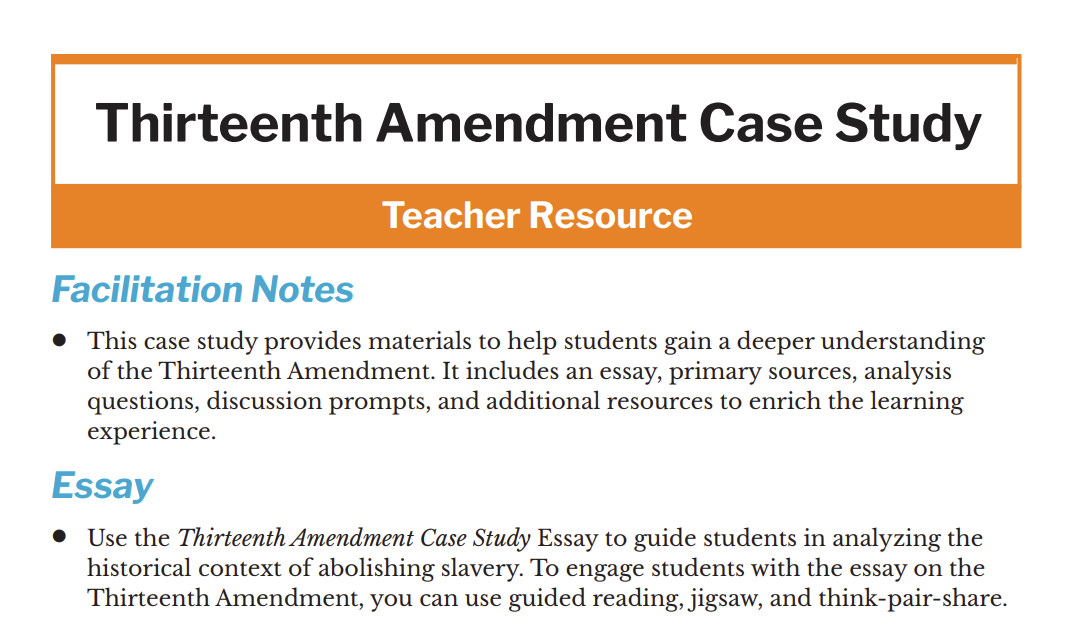Thirteenth Amendment Case Study | Teacher Resource

Facilitation Notes
- This case study provides materials to help students gain a deeper understanding of the Thirteenth Amendment. It includes an essay, primary sources, analysis questions, discussion prompts, and additional resources to enrich the learning experience.
Essay
- Use the Thirteenth Amendment Case Study Essay to guide students in analyzing the historical context of abolishing slavery. To engage students with the essay on the Thirteenth Amendment, you can use guided reading, jigsaw, and think-pair-share.
- In guided reading, the class reads and annotates sections together, pausing for discussion and clarification.
- The jigsaw method divides the essay into sections for groups to analyze and teach to peers, ensuring collective understanding.
- With think-pair-share, students reflect individually, discuss insights with a partner, and share ideas with the class, promoting collaboration and critical thinking.
Primary Sources
- Use the Thirteenth Amendment Primary Source which includes an image and text from a broadside of the Thirteenth Amendment along with the analysis questions.
Analysis and Discussion Questions
- The following discussion questions can be used in various ways to engage students. You can facilitate a traditional whole-class discussion, pair students for partner discussions, or assign the questions as prompts for personal writing or reflective journaling. Small group discussions can be organized, with students taking turns leading the conversation, or you can create a ‘gallery walk,’ where students respond to questions posted around the room. Additionally, these questions can be integrated into a digital discussion board for asynchronous participation. Choose the approach that best aligns with your teaching goals and your students’ needs.
- What is the significance of the phrase “neither slavery nor involuntary servitude” in the Thirteenth Amendment?
- How do you think the concept of freedom is tied to the idea of forced labor or servitude? Can you think of situations today where people might still experience forms of forced labor or unfair treatment? How can we prevent that from happening?
- Why does the Thirteenth Amendment include the exception for “punishment for crime”? What impact might this have had on the legal system?
- How do you think this exception has affected people in prison today? Do you think it’s fair for someone to be forced to work while in prison? What changes would you suggest to make sure prison labor isn’t used unfairly?
- What legal and societal changes would the passage of the Thirteenth Amendment bring about after its ratification?
- After the Thirteenth Amendment was passed, what challenges do you think newly freed African Americans faced in their everyday lives? How can people today help make sure that all individuals are treated equally, no matter their background?
- How did the Thirteenth Amendment differ from the Emancipation Proclamation, and why was the amendment necessary even after the proclamation?
Additional Resources
- When planning to teach a lesson on the Thirteenth Amendment, reviewing these resources can provide valuable context and enhance your knowledge of the subject.
- Uncle Abe’s Valentine: Bridge from the Past Video
- A short, engaging video exploring Abraham Lincoln’s views on slavery and the Constitution, designed around an exploration of visual primary sources.
- Slavery and the Constitution Essay
- An in-depth essay examining the compromises over slavery in the U.S. Constitution and their long-term impact on American history.
- The End of Slavery and the Reconstruction Amendments Essay
- A comprehensive essay detailing the passage of the Thirteenth, Fourteenth, and Fifteenth Amendments and their role in reshaping American society after the Civil War.
